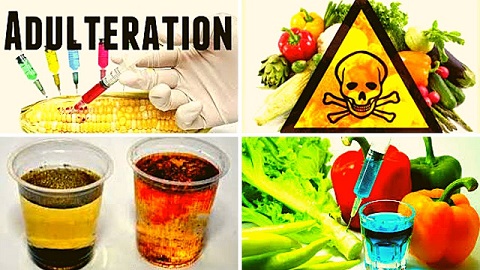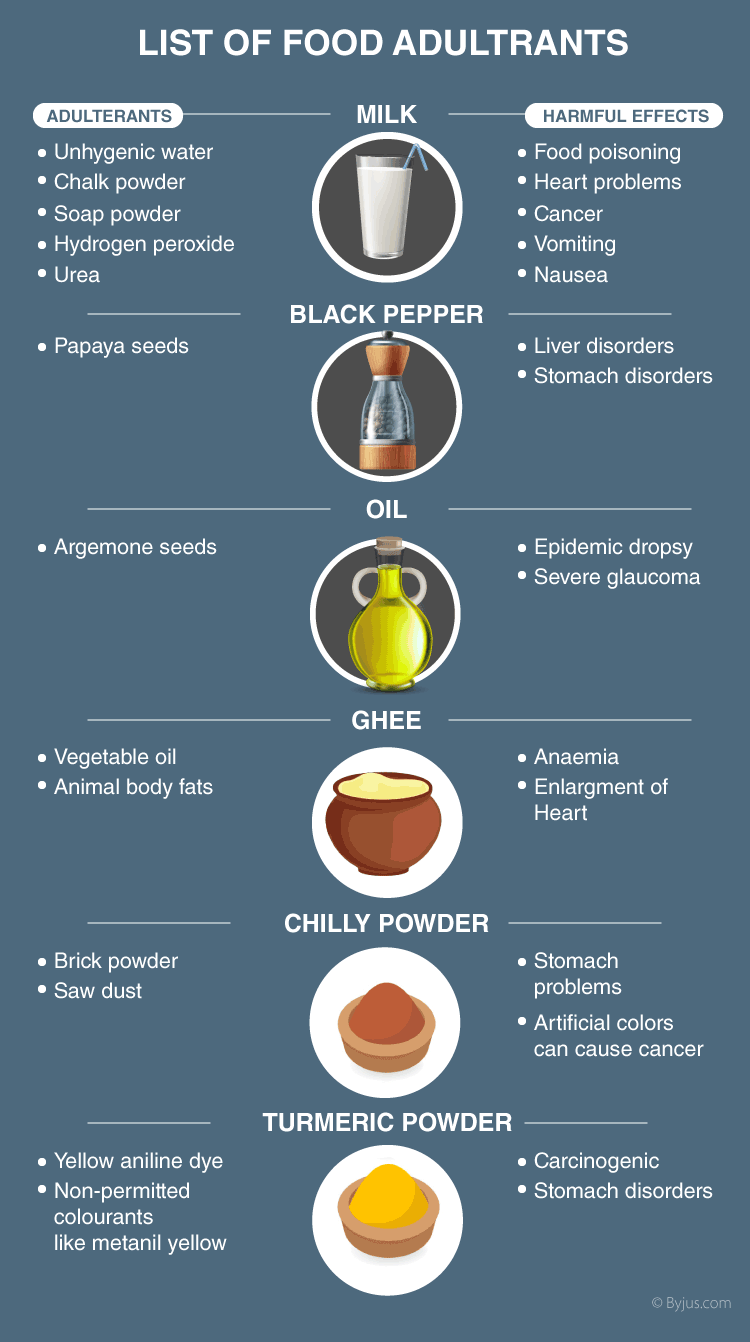
- Food adulteration is the intentional addition of non-permitted foreign matter in food which increases the volume and weight of food. This helps increase volume of trade by showing lower prices leading to more economic gains.
- Sometimes, food adulteration may be incidental as well.
- The health of consumers is compromised if they consume adulterated food. It may endanger and affect their physiological functions due to either addition of a deleterious substance or the removal of vital components.
- Food adulteration may occur either by:
- Deliberate or intentional addition, substitution or subtraction of substances which adversely affect the quality of foods.
- Incidental contamination of foods with deleterious constituents such as toxins, insecticides, pathogenic bacteria and fungi due to negligence or lack of proper storage facilities.
- Contamination with harmful microorganisms during production, packaging, storage and handling.
What are food adulterants?
- Food adulterants are foreign substances that are employed or could be employed into food for the purpose of adulteration.
- The most common adulterated food and food adulterants are;
- Milk: Water, soda
- Ghee: Hydrogenated fat, animal fat
- Vegetable oils: cheap/non-edible Linseed, minerals oil
- Wheat and rice: Stones, stone muds, marble chips
- Wheat flour: Maida, Chalk powder and lime powder
- Bengal gram daal: Kesari daal
- Chili Powder: Red dye
- Black pepper: Dried papaya seeds, tea

https://byjus.com/biology/food-adulteration/
Types of food adulteration:
- Incidental or Indirect adulteration
- Intentional or Direct adulteration
- Metallic adulteration
- Incidental or Indirect food adulteration:
- This is an accidental addition of adulterants to food. It may result due to ignorance, negligence, or improper facilities during food production, packaging, storage or handling.
- g. Larvae of insects, droppings of birds and insects, pesticide residues, etc.
- Intentional or Direct food adulteration:
- This is a deliberate or intentional addition of inferior materials to a food. Traders normally employ this method to heighten appearance qualities and to gain greater profits.
- g. Marble chips and stones in rice and dal, chalk powder in flour, dyes, mineral oils etc.
- Metallic food adulteration:
- Accidental or intentional addition of metallic materials into food.
- g. Lead (turmeric coated with lead chromate), arsenic (drinking water and fruits), mercury (marine fish contaminated with dimethyl mercury), tin, cadmium, cobalt etc.
Health Hazards of food adulteration:
Consumers suffer from various health hazards due to consumption of adulterated food. Some are as follows:
- Permitted food color like metanil yellow (in turmeric powder and Arhar dal) if used beyond the safe limit in colored food can cause allergies, hyperactivity, liver damage, infertility, weakness, vomiting, anemia, cancer, birth defects etc.
- Mineral oil added to edible oil and fats are also carcinogenic.
- Lead chromate when added to turmeric powder and spices can cause lead poisoning leading to epigastric pain, nausea, constipation, anemia, insomnia and mental retardation.
- Potassium dichromate in curry powder can cause gripping pain in the abdomen and giddiness.
- Water and liquors contaminated with cobalt and can cause cardiac damage. Similarly, copper, tin, and zinc can cause colic pain, vomiting and diarrhea.
- Mercury fungicide treated grains, dimethyl mercury-contaminated fish if consumed can cause brain damage, paralysis, and even death.